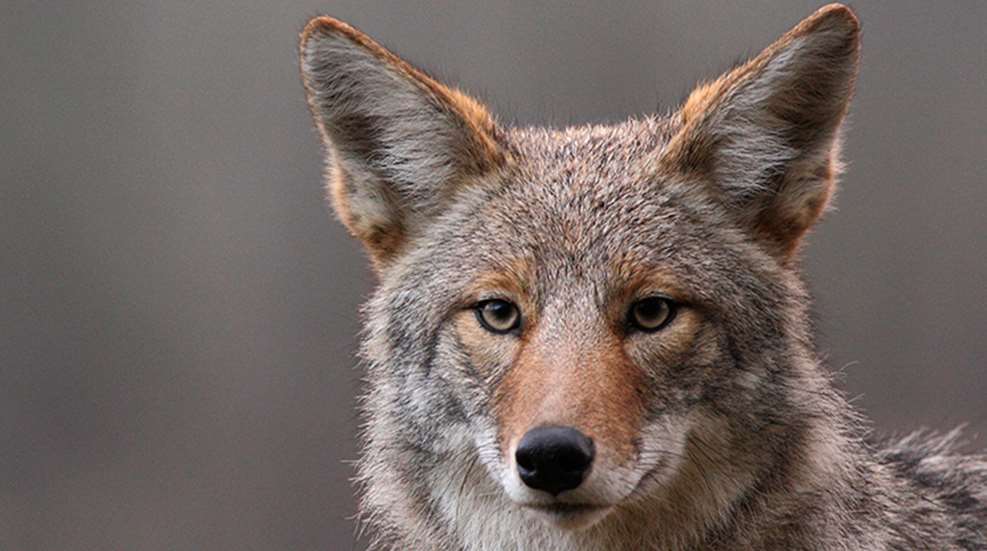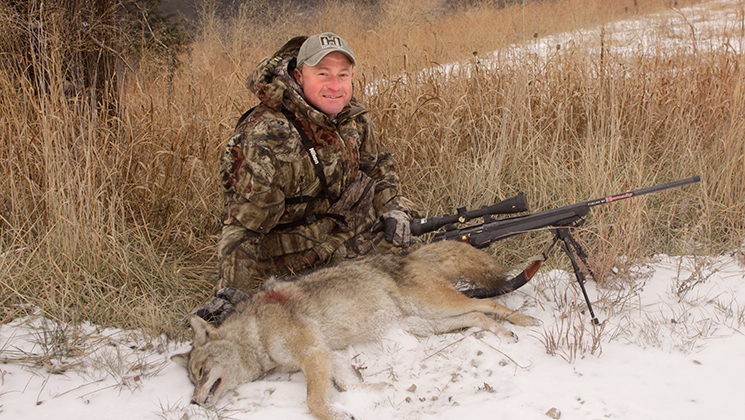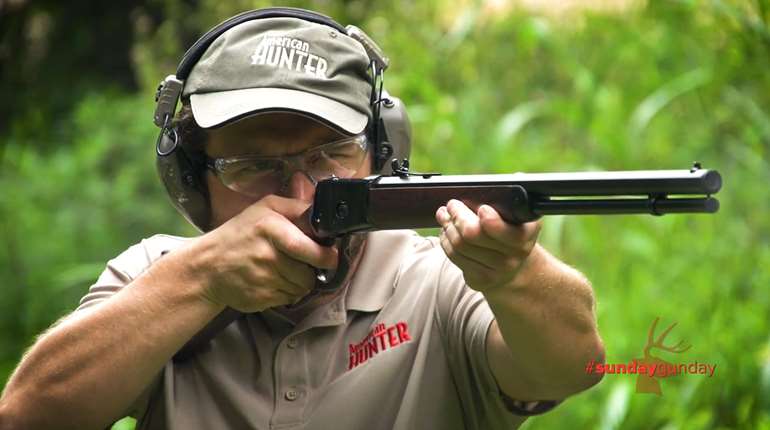
Coyotes are coyotes, East or West. Nevertheless, ask any Eastern coyote hunter his views on the new wildlife neighbor that’s been steadily expanding since the 1980s and you’ll hear stories of predators that don’t play by the same rules as their Western counterparts. Paranoia and cunning combine to create a coyote lifestyle that requires a deviation from coyote-calling tradition. Disgruntled coyote hunters east of the Mississippi have started to leave tradition to their Western colleagues and forge a new path to success.
Regardless of your home’s GPS waypoint, Eastern attack plans may help you put a coyote in your truck bed this season. Is it time for you to become an Easterner in the coyote sense?
Jerry Lannen, a 20-year veteran of the Eastern coyote frontlines, hails from Pennsylvania. Coyote cravings stirred the Keystone State hunter to create custom hand calls, Deadly Dose Game Calls, to target his quarry. But even with the custom calls in his hand, Eastern coyotes have still been a thorn in Lannen’s side. He’s been sending the barbs right back at Eastern coyotes by changing his hunting strategy.
“I enjoy watching predator hunting on TV,” admits Lannen. “I’m a bit jealous when I see a Western hunter call in and shoot five or more coyotes in a single day. Heck, most Eastern predator hunters are lucky to call in and shoot five coyotes a season. If you kill 10 in Pennsylvania you’re a hero.”
Although Lannen won’t lay claim to an expert title, his consistent success reveals that tailored tactics are making a difference in his annual fur take. Even with increasing densities, he understands the song dogs aren’t as plentiful in his back yard as many Western locales. Because of that, his first step toward success is scouting with the drive of a private investigator.
Get a Private-Eye Preview
Lannen believes most Eastern coyote hunters are not setting up where coyotes live. In brief, they simply overlook the aspect of scouting. He knows Western coyote hunters scout, but with Eastern coyotes it’s everything.
“You have to set up where coyotes can hear your calls,” stresses Lannen. “That means spending as much time trying to locate coyotes as you do hunting. If you know where they are, your chances of calling them in are just that much greater.”
As an all-around hunter, Lannen equates many of his coyote strategies to deer and turkey hunting. In fact, when he’s hunting other species he’s always scouting for coyotes. He’ll look for coyote tracks on the way to a treestand and scan trails for scat while in the turkey woods.
His go-to scouting aid has an audible ring to it: howls. After sunset Lannen gets behind the wheel and drives routes bordering suspected coyote haunts. Periodically, he’ll stop and howl in the hope of getting a reply.
To get the most out of return howls, Lannen immediately refers to downloaded maps on his smartphone. Not only does he mark the location of coyotes, but he’ll quickly assess whether he can hunt the area on the spot, return later or save it for more boots-on-the-ground reconnaissance. That’s all determined by habitat, whether he has permission to hunt an area and what strategy he believes is necessary.
If he had to pick one area that always has coyote activity it would be “anything rocky.” Hollows or hillsides with rocky, overgrown terrain attract coyotes, and Lannen knows coyotes will be nearby as they seek out these areas for daytime cover.
Rick Ward, a 30-year coyote hunter, grew up in Texas using Western tactics. Now he lives in Georgia and readily admits that coyotes east of the Mississippi have a different way of doing things. In addition to being a founding member of the Georgia Predator Hunting Association, Ward also promotes high-powered air rifles for predator hunting in developed areas through his company, Urban Airgunner. In his opinion, too many Eastern coyote hunters neglect scent control and don’t carefully consider setup sites. It gives them away more often than not.
“I tell people to bowhunt their coyotes,” Ward advises. “In the East it’s a close-proximity game. You don’t see them coming from a mile out like in the West. You don’t have time to think about what’s going to happen. If you don’t have the wind working in your favor you’ll never see a coyote with all the cover, and if you do it’ll pop its head out of cover giving you just seconds to react.”
Thick cover hampers Ward’s Georgia coyote hunts, but he solves the issue by seeking out peanut fields. In particular, he looks for fields traversed by irrigation ditches; the reason makes as much sense as Lannen’s rocky terrain theory.
“Even in the late fall it can be hot in Georgia, and coyotes are trying to stay cool just like me. I scout for irrigation ditches in fields. The water keeps these low spots 10 to 15 degrees cooler, and the overgrown cover gives coyotes a place to hide all day. Once I find an irrigation ditch with those elements, I look over the property and find four different ways to enter it so I can hunt regardless of the wind direction.”
All-Points Tip
Lannen and Ward rely on scouting for coyotes just as most whitetail hunters. To speed up scouting missions, East or West, add map apps and landowner downloads to your smartphone or GPS. Trimble Outdoors via the MyTopo app gives you access to 68,000 topo maps in the United States and Canada, plus you have access to aerial photos to see the landscape and compare it to a map format.
OnXMaps gives you similar mapping capabilities with landowner information for many states. Check out ScoutLook Weather (scoutlookweather.com) and its Google Earth interface for a fully interactive mapping and weather program. Its mapping, weather and hunting-log features help you to track patterns and trends on your stands. You can also mark locations of howling coyotes to determine home territories.
Set out a Welcome Mat For Everyone
As coyotes spread east they don’t necessarily fill habitat niches with blinking “vacancy” signs. Bobcats, bears, foxes and even mountain lions share the terrain, and most predator hunters are equal-opportunists. They don’t really care which furbearer shows up to the squalls. Lannen isn’t afraid to confess most of his coyotes don’t fall to prey-in-distress calls. Still, he knows that calling in a predator in the East is an accomplishment, so he starts most stands with a welcome-mat message.
“Unless I’m strictly focusing on coyotes, I usually go after foxes and coyotes at the start of my set by sending a message for all stomachs,” Lannen describes. “A prey-in-distress call, like a dying rabbit, could bring in a fox or a coyote. I’ll give that message 15 to 20 minutes, and if there’s no response then I’ll add howls to zero in on coyotes in the closing minutes of the setup.”
His initial howls represent a lone, nonaggressive coyote. Occasionally he places an electronic caller several yards from his location to add the howls of a second coyote. If a coyote responds, Lannen then begins to mimic the answering coyote. If the coyote changes tone to an aggressive, challenge howl, Lannen fires right back to keep the conversation going.
Ward’s Georgia ZIP code is no different, and he mixes in prey-in-distress sounds, such as chickens or kittens in distress, to troll the so-called predator waters. These sounds may call in a coyote, bobcat or the overabundant gray fox.
“I was trying to impress a plantation owner one year and get him to give me permission to hunt his property. A trapper had been working the area so I used a setup that would work for anything within hearing distance thinking predator numbers would be low. Boy was I blessed. I called in two coyotes on the first stand. It impressed the landowner, but on the second set I called in a coyote and a bobcat. It made that guy take notice that calling can be just as effective as trapping for predator management. And yes, I got permission to continue hunting the property.”
Interestingly, when Ward does want an all-out push on coyotes he uses gray-fox-in-distress. His experience shows that coyotes respond as well or better to gray fox cries when compared to rabbit distress “any day.”
All-Points Tip
Lannen and Ward’s approach to calling as many species as possible has merit everywhere. Most locations house coyotes, foxes and bobcats. In recent years mountain lions have been reclaiming their previous coast-to-coast haunts, plus black bears also are adaptable to many environments across the country. That noted, you never know what will show up so send a warm welcome for everyone.
Since the top predators often prey on predators lower on the pyramid, you don’t want to use sounds that may send the lesser ones scurrying for cover. A good example is the current trend of using coyote vocalizations. Howls may tempt a call-shy coyote into range, but rest assured no red fox, bobcat or even mountain lion will show. Sounds to mimic at the start include those from the little animal section. Few predators can ignore the tasty snack of a cottontail, a wounded bird or a squeaking squirrel.
Embrace a Batman Schedule
“Ninety percent of my calling and hunting is done at night,” states Lannen. “As soon as it starts getting dark I’ll go out and howl to locate them. If I get a response it’s all about getting close and finding a field you can call them into. If my maps show that the area is all timber, I’ll mark the location and return right at shooting light. It’s not only hard to navigate in the woods at night, but it’s also difficult to see coyotes coming to your call.”
Using a red-lens headlamp, Lannen scans the fields for coyotes circling and when he spots eyes, he brightens the scene with a red-lens Night Eyes predator light. He only adds the shooting light seconds before he pulls the trigger to avoid spooking coyotes from the brightened scene.
“Coyotes are more talkative and active at night where I hunt. In fact, it’s rare to hear a daytime coyote howling. Last year I heard one howl at 8 in the morning, and that’s the latest I’ve ever heard one talking,” adds Lannen.
Ward’s no stranger to hunting coyotes at night, especially with the drop in prices for Gen 2 and Gen 3 night-vision products. And as coyotes expand into urban areas, he knows they prowl neighborhoods after dark. In the right area, it’s the perfect recipe for success.
“I had one coyote elude me for months on a property inside city limits adjacent to an airport. The property has a clause to allow the discharge of a firearm to protect cattle, but I still couldn’t corner the coyote in daylight. Finally I asked the landowner if I could hunt at night,” tells Ward. “After starting calls I spotted the coyotes coming right at me with my night vision. A trio was sneaking through a pecan grove. I shot the first one at 65 yards, swung and dropped the second, and the third one ran right by me. I would have had that one, too, but it was headed into town and I didn’t want to take a risky shot with all the city lights in the background. It was definitely one of my most exciting coyote hunts.”
If you do embrace a Batman hunting style, both hunters suggest you contact landowners and share your plan. You don’t want farmers calling authorities in the middle of the night when they hear shots on the back 40.
All-Points Tip
It’s no secret that predators prowl at night. They feel confident moving about under the cover of darkness. Human activity plummets after dark. Plus, cooler nighttime temperatures, especially in the Southeast, offer pleasant relief for comfortable hunting. If your state allows night hunting, especially with night-vision aids, embrace the strategy.
First, scan your calling area nonstop. Sweep the night-vision aid or red light back and forth across the area where you expect predator action. With lights it’s best to sweep with the edge or halo of the light, instead of using the harsher middle section of the beam.
Next, be sure of your target and your ability to judge game in the dim conditions. You may have to identify animals by body size, the size of their eyes and the manner in which they approach. Coyotes, foxes, bobcats and raccoons all have different body shapes along with varying gaits. It’s common to have two or more species show up at your nighttime setup, so learn the traits of each predator in your area for proper identification.
Finally, once you locate a set of approaching eyes, keep them illuminated with the light’s edge. When you are sure of the target, aim the main beam of light onto it as you prepare to press the trigger. Coyotes will likely be the most cautious so be prepared for a longer shot into the darkness.
It’s in the Details
Coyote hunting anywhere is about details. When you combine dense, Eastern habitat and cautious attitudes you really need to pay attention to the little things. Most predator hunters still adapt a scent
philosophy of setting up downwind of where they expect predators to show themselves. Lannen follows that code in daylight, but flips the tables at night. His standard nighttime setup is to locate an open field bordered by timber. He positions himself with the timber behind him and with the wind at his back blowing toward the field.
Why? He knows predators will circle downwind to scent-check an area. If they circle and the wind is blowing his scent into the timber, he may never see an animal in the darkness. This is especially true in thick cover. But if the animal has to circle in an open field, he has higher odds of spotting and shooting it before it walks through his scent stream.
Ward also has a unique setup approach, and it involves farm equipment. As he scrutinizes a field location for a calling site he’ll scan for machinery parked after a day of farm work.
“Predators have lots of interaction with farmers and tractors bumping around fields. And because of that they aren’t hesitant about approaching a parked tractor,” explains Ward. “I look for tractors sitting on a field edge or even peanut wagons. In the right downwind location, they give me an elevated place to set up and call from. I can call right from the tractor or put an electronic caller out a few yards to direct attention away from my perch."
All-Points Tip
Lannen’s upwind calling position may go against everything you ever learned about predator hunting. But just as the technique works for him in the East, it holds merit for Western locations covered in brush as well as with crafty predators that tend to circle the call before showing themselves.
Scout for a location with a downwind corridor that will give you ample views to spot incoming predators. Access the stand with the knowledge you’ll be alerting everything downwind, but with enough familiarity of the land to have blocks of cover upwind and parallel to your calling position where predators won’t sense your presence. Place your electronic caller in the alley, and then gain elevation for a grand downwind view. Any predator that shows up will want to circle downwind. Your job is to bust it before it busts you.






































